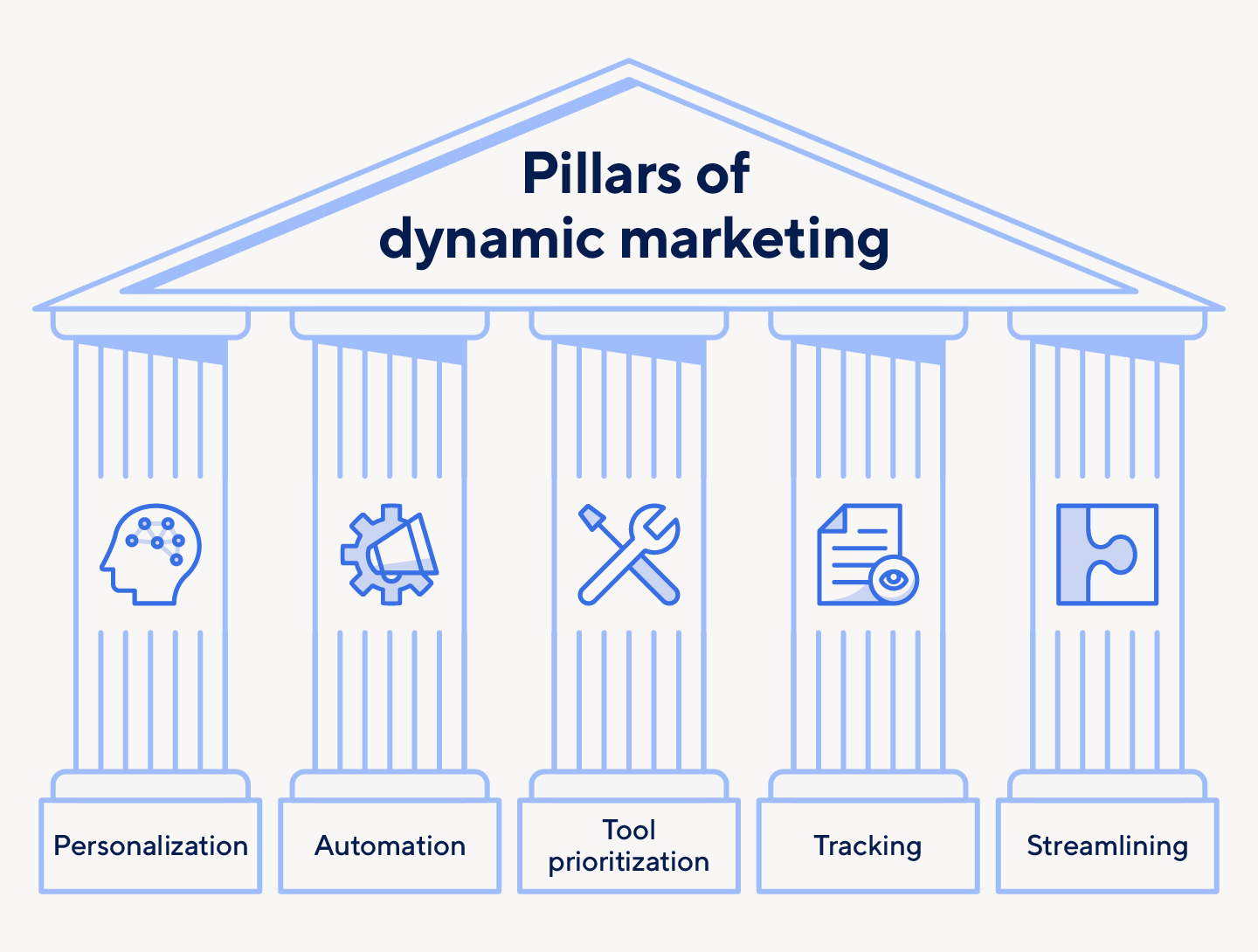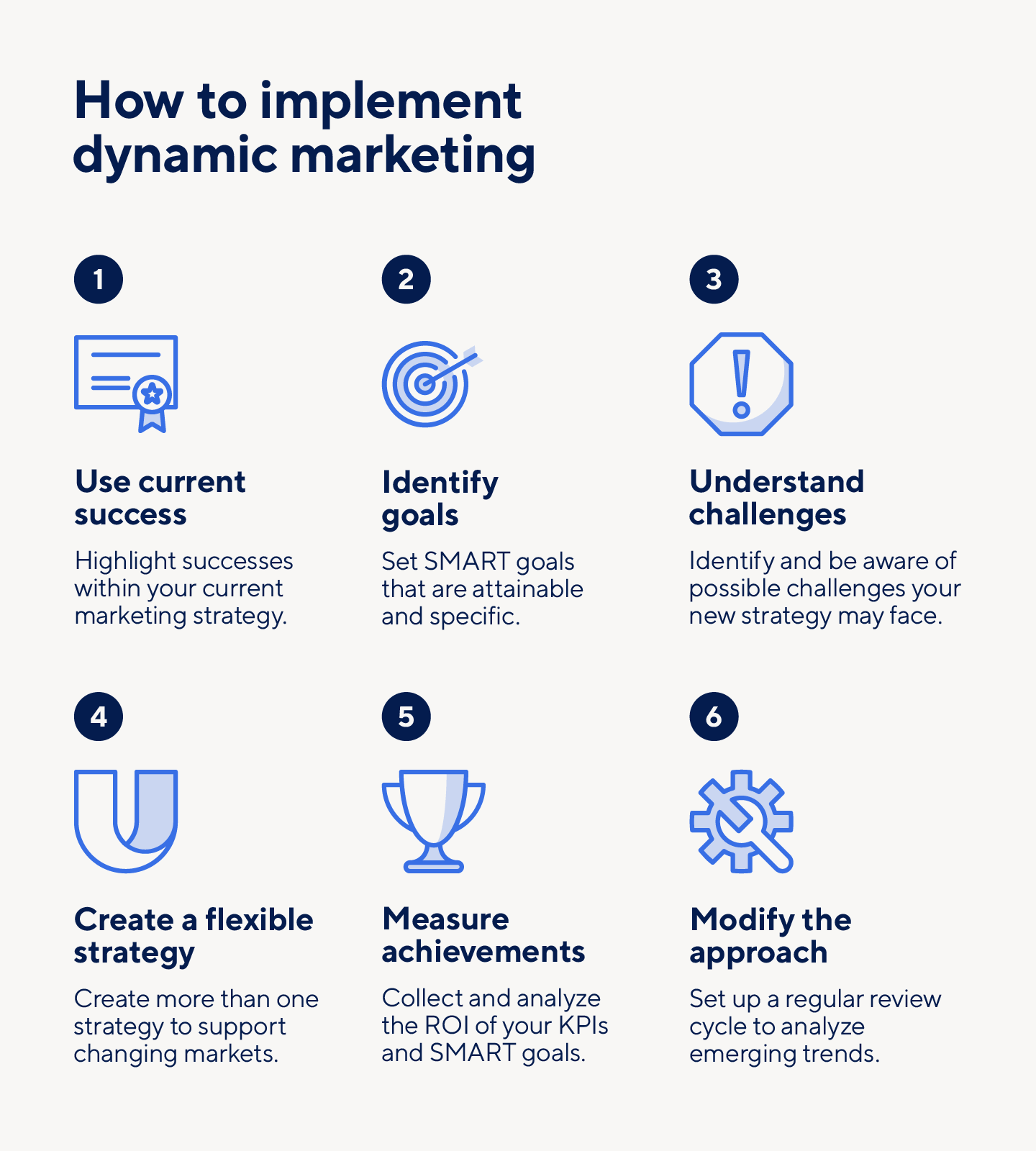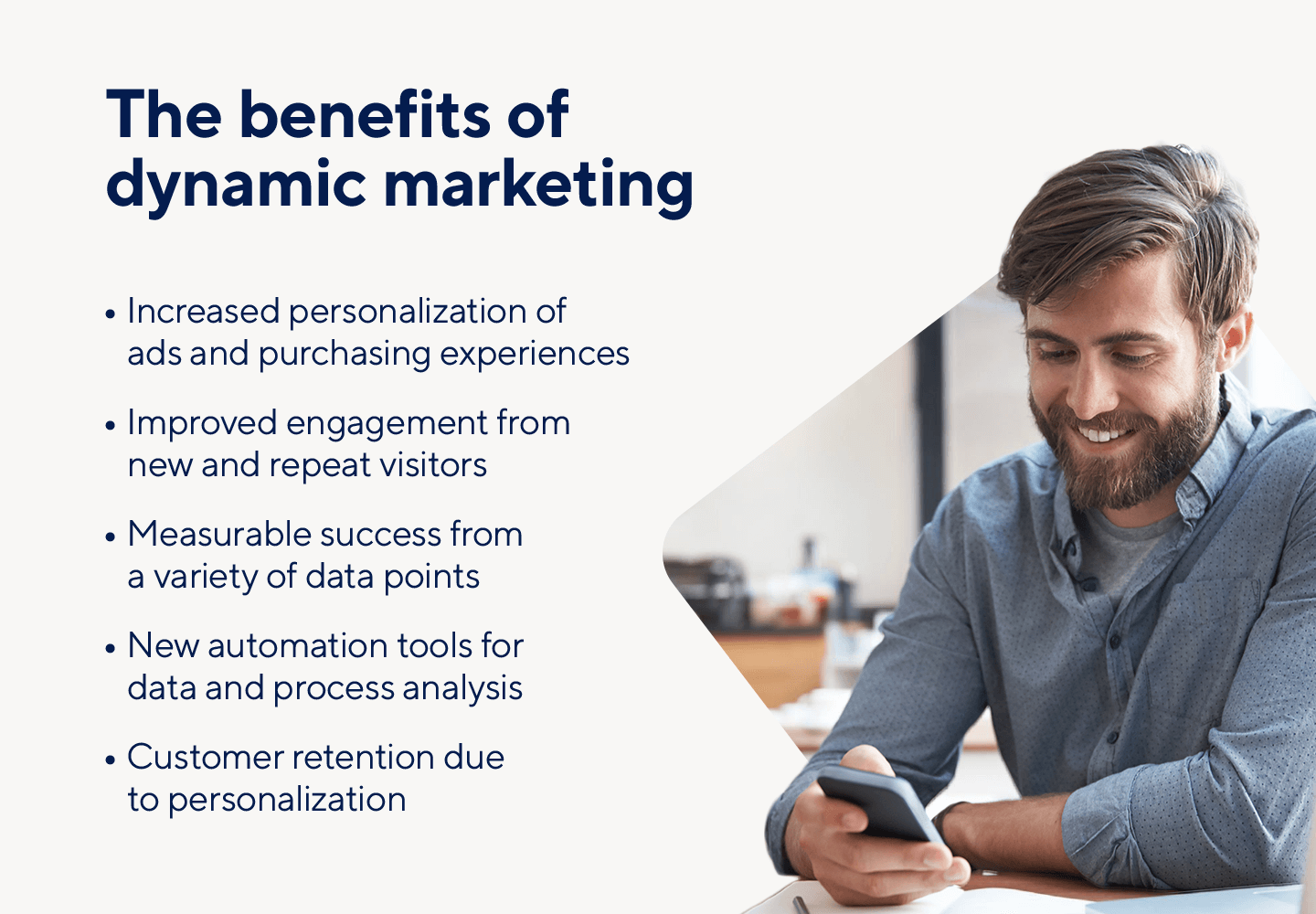What Is Dynamic Marketing?
Dynamic marketing is a strategy designed to help marketers create flexible, responsive marketing programs based on customer data. Dynamic marketing programs often adapt to changing expectations, technologies, and preferences to continuously elevate and prioritize the user experience.
While dynamic marketing depends on flexibility and adaptability, it still requires a strong foundation with expectations and metrics of success. To be successful, dynamic marketing strategies need the following:
- A lead management platform
- A central database for sales and marketing data
- A personalizable engagement platform for customer communication
- A process to measure and monitor the ROI of key performance indicators
Additionally, a dynamic marketing foundation can only evolve with its audience if it relies on five major pillars:
- Personalization: Personalization is the process of creating or adapting systems, processes, and tactics to meet an individual’s expectations, wants, and needs.
- Automation: Automation is the act of implementing and using systems to automatically perform specific tasks, including data collection and analysis.
- Tool Prioritization: Tool prioritization refers to when markets vet and choose the best marketing tools and platforms for their goals, which create a stronger marketing system.
- Tracking: Tracking allows you to create benchmarks to evaluate the effectiveness of your strategy, as well as any challenges you face, at predefined time intervals.
- Streamlining: Streamlining is achieved through the automation, simplification, and elimination of tasks within a project or process by updating or advancing marketing technology and tools.
If implemented correctly, dynamic marketing can level up a company’s marketing efforts and outcomes.
Key Factors To Consider
In order to successfully integrate a dynamic marketing strategy, you’ll need the strong foundation described above. But, there are also four key factors teams and companies should consider when redesigning their marketing: customer profiles, qualified leads, data collection, and streamlined processes.
Let’s take a look at each of these four factors in greater detail:
- Customer Profiles: Data-backed customer profiles can help marketers analyze and understand target audiences, which can direct strategies to cater to ideal customers.
- Qualified Leads: Loyal customers have common characteristics — including acquisition costs, retention rates, and behavior patterns — which can help marketers determine potential leads and anticipate successful strategies.
- Data Collection: Instead of collecting excessive quantities of data (which often ends up over-complicating strategies), dynamic marketing urges marketers to use current data — and collect better data designed to support market research, prove or disprove data theories, and answer specific questions about an organization’s campaigns and processes. Where data is concerned, quality over quantity is key.
- Streamlined Processes: Creating streamlined, simple processes can lead to successful transitions and loyal customers. You can also use customer feedback or behavior patterns to define these processes.
While a dynamic strategy can still be successful without considering these key factors, it is best practice to prepare for the needs, behaviors, and expectations associated with each.
How To Implement Dynamic Marketing
After building a foundation and considering the key factors and best practices of dynamic marketing, it’s time to implement your new strategy. You can achieve successful implementation in six steps, described below.
1. Use Current Success as a Guide
You don’t need to start from scratch to create a profitable dynamic marketing strategy. If you currently have a marketing strategy in place, identify which aspects have been successful. You can measure these aspects using the company’s goals and mission, or a department’s overall KPIs (or both). Don’t be afraid to collaborate with other departments, like sales, during this step to determine which aspects are worth preserving.
2. Identify Goals
After identifying current successes, it’s time to set and identify new dynamic marketing goals. Using current data, consider setting SMART goals to guide your team toward specific, attainable achievements. This step can also evaluate current organizational goals, reevaluate company expectations, and realign business goals across a variety of teams. Additionally, SMART goal templates are flexible and shareable, so your whole team can be part of the goal-setting process.
3. Understand Challenges
Setting goals is important, but don’t expect to achieve them without encountering challenges. During this step, teams should identify where challenges may arise and brainstorm ways to overcome them. For example, it’s important to recognize how economic trends may affect supply and demand, how seasonal changes may influence customer behaviors, and how technology updates could affect production schedules.
4. Create a Flexible Strategy
After identifying your current successes, SMART goals, and potential challenges, it’s time to develop a flexible dynamic strategy based on your collected data and key factors.
Remaining flexible in your schedules and expectations is vital in order for the below strategy components to be successful:
- Seasonal changes
- Technology updates
- Automation integrations
- Customer support
- Branching workflows
- Customer journeys
At this stage, teams are encouraged to create more than one marketing strategy. Each strategy should prioritize unique components or key factors and offer different product timelines or launch plans.
These strategies should be designed to support each other if a company needs to pivot or change direction:
- Production schedules and product plans should include extended or shortened timelines for scheduling flexibility.
- Teams implementing new technology or automation tools should consider creating strategies with various buffer times for a product or plan’s launch.
- Each dynamic strategy can focus on different aspects or benefits of a product or service to differentiate their intents.
- The customer engagement opportunities within each strategy can help marketers reach certain goals.
- The levels of personalization in a brand’s marketing strategy can intensify or recede based on the reaction of a target audience.
5. Measure Accomplishments
One of the most important steps when implementing a dynamic marketing strategy is to measure its accomplishments. During this step, digital marketing tools can help you recognize if your strategy is successful and where modifications could improve its effectiveness.
If your strategy began with a strong foundation, you should have a process dedicated to collecting and analyzing the ROI of your KPIs. You can use anything from a third-party analytics platform to an in-house reporting system to gather and examine this data.
For a digital dynamic marketing strategy, you should consider measuring your accomplishments by analyzing the following:
- Source Traffic: This indicates where your traffic and prospective customers are coming from, which helps you determine which entry points in your strategy are successful. Source traffic can determine if your traffic is direct, paid, organic, or affiliate.
- Repeat Traffic: If new visitors become repeat visitors, this data can signal how profitable your user experience is.
- Session Duration: This data communicates how long visitors spend on your site getting to know your brand, products, and services.
- Exit Rate: The pages visitors exit most often can show where your strategy is least effective and may indicate where you should refocus your efforts.
- Bounce Rate: Bounce rates are calculated on the first page a customer visits. If you notice a specific page has a high bounce rate, consider reevaluating its content or user experience.
- Conversion Rate: Customer conversion rates are a great indicator of your strategy’s success. There are various types of conversions, depending on your goals:
- Subscribe to a newsletter or email list
- Sign up for updates
- Purchase a product or service
- Download an item
6. Modify the Approach
After implementing and measuring the success of your dynamic marketing strategy, set up a consistent review cycle. This cycle will allow you to analyze new customer data and adjust your strategy according to emerging patterns and trends. Additionally, you can create surveys and record customer feedback about your strategy to modify your approaches based on specific responses during this step.
Benefits of Dynamic Marketing
Laying the groundwork for dynamic marketing can be extensive — and sometimes exhaustive — but the payoff is worth it. Dynamic work can elevate expectations and results, and these strategies can also deliver a variety of benefits.
Personalization
Many marketers see vast improvements in their ROI when they prioritize personalization. Since dynamic marketing relies on customer data, you can easily customize dynamic strategies to produce personalized purchasing experiences, advertising, and marketing campaigns based on an individual’s interests. Brand recognition and revisits are also more likely to occur with customers and visitors who feel their wants and needs are recognized.
Engagement
Due to personalization, dynamic marketing strategies also frequently see increased customer engagement. Whether visitors are interacting with advertisements, sharing posts on social media platforms, or converting into customers, this type of marketing encourages various types of engagement.
Measurable Success
Customer data is used to determine decisions and create strategies, and customer behavior is then used to measure the success of a campaign, individual strategies, and the company, product, or service as a whole. Surveys and other feedback forms can also quickly determine the success or failure of brand awareness, and other data can be used to measure ROI, sales, revenues, and profits.
Automation
Because dynamic marketing is flexible, you can utilize flexible marketing tools, including automation tools. These tools can automatically review customer data, make inferences about customer behavior, identify changes to behavioral patterns, and increase efficiency with workflow automation. Instead of dedicating team members to these actions, marketing teams can prioritize decision-making and strategy modification.
Retention
Flexible, personalized strategies can also help increase customer retention. A strategy’s attentiveness to its customer needs (and therefore, the strength of its marketing messages) can encourage long-term relationships and word-of-mouth marketing that a brand may not otherwise receive.
Challenges of Dynamic Marketing
Implementing a new strategy always comes with challenges. When it comes to dynamic marketing, there are three consistent challenges marketers often face, but knowing what they are can prepare users for them.
Constant Evolution
While flexibility is an integral part of dynamic marketing, it can also be a challenge. Because customers change and produce new data, strategies must constantly evolve to prioritize customer needs and maximize their behaviors.
This type of evolution requires marketing teams to be willing to evolve with their strategies — no matter when the changes happen or what that means for their campaign creation. Constant evolution can also take a toll on some forms of technology. Updating data analysis processes is crucial to obtaining usable, necessary information on patterns and trends, but not all forms of technology can update and develop in stride with a strategy’s customers.
Data Collection
Dynamic marketing can do incredible things with customer data, but too much data can hurt a strategy if not selected and analyzed properly. Improper data collection can lead to various issues:
- Data silos
- Ineffective or inaccurate data
- Excessive data
- Aged data
Additionally, data collection calls for increased and updated security measures, which can be expensive and complicated. Entire teams for data analysis and protection may be required when creating a dynamic marketing strategy, so be aware of the potential challenges data collection may pose.
Team Unification
For dynamic marketing strategies to succeed, the team behind them needs to be unified. If a team does not have a singular goal — or set of goals — with the same steps designed to reach these goals, it is unlikely that their strategy will succeed. Inconsistent results will occur if only part of a team agrees to use automation, pursue personalization, or prioritize flexibility.
Streamline Processes and Drive Results With Smartsheet for Marketing
The best marketing teams know the importance of effective campaign management, consistent creative operations, and powerful event logistics -- and Smartsheet helps you deliver on all three so you can be more effective and achieve more.
The Smartsheet platform makes it easy to plan, capture, manage, and report on work from anywhere, helping your team be more effective and get more done. Report on key metrics and get real-time visibility into work as it happens with roll-up reports, dashboards, and automated workflows built to keep your team connected and informed.
When teams have clarity into the work getting done, there’s no telling how much more they can accomplish in the same amount of time. Try Smartsheet for free, today.


